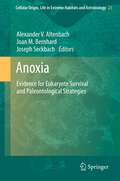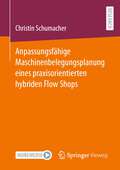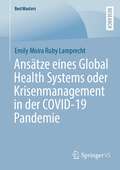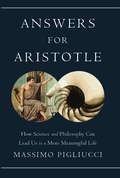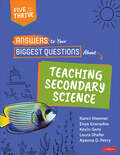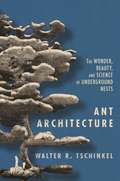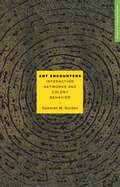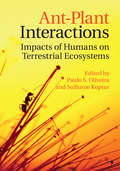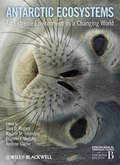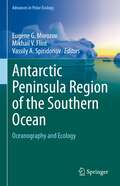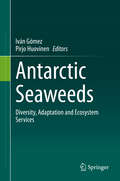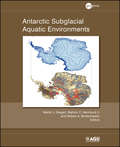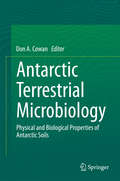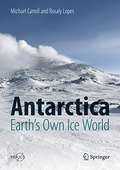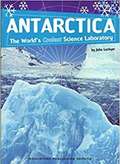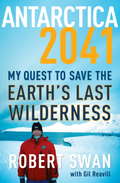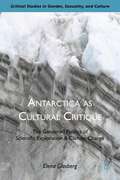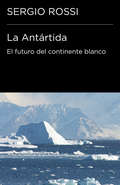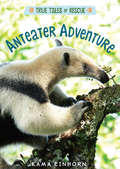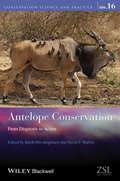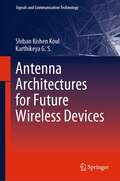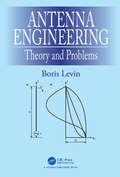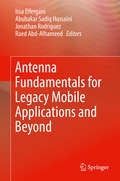- Table View
- List View
Anoxia: Evidence for Eukaryote Survival and Paleontological Strategies (Cellular Origin, Life in Extreme Habitats and Astrobiology #21)
by Joseph Seckbach Joan M. Bernhard Alexander AltenbachANOXIA defines the lack of free molecular oxygen in an environment. In the presence of organic matter, anaerobic prokaryotes produce compounds such as free radicals, hydrogen sulfide, or methane that are typically toxic to aerobes. The concomitance of suppressed respiration and presence of toxic substances suggests these habitats are inhospitable to Eukaryota. Ecologists sometimes term such environments 'Death Zones'. This book presents, however, a collection of remarkable adaptations to anoxia, observed in Eukaryotes such as protists, animals, plants and fungi. Case studies provide evidence for controlled beneficial use of anoxia by, for example, modification of free radicals, use of alternative electron donors for anaerobic metabolic pathways, and employment of anaerobic symbionts. The complex, interwoven existence of oxic and anoxic conditions in space and time is also highlighted as is the idea that eukaryotic inhabitation of anoxic habitats was established early in Earth history.
Anpassungsfähige Maschinenbelegungsplanung eines praxisorientierten hybriden Flow Shops
by Christin SchumacherIn der Produktionsplanung ist es eine tägliche Herausforderung, die beste Maschinenbelegung im Hinblick auf das Unternehmensziel zu finden. Dabei gilt es zu entscheiden, welches Produkt zu welchem Zeitpunkt auf welcher Maschine produziert werden soll. Für anwendungsorientierte Szenarien müssen eine Reihe von Nebenbedingungen sowie stochastische Einflüsse beachtet werden. Um ein für die Praxis möglichst relevantes Problem zu adressieren, wurden folgende immanente Charakteristika realistischer Maschinenbelegungsprobleme einbezogen: Maschinenausfälle, Unsicherheit in Prozessparametern, geplante Wartungen sowie Schwankungen der Produktionsbedarfe. Mithilfe einer entwickelten Software wird die Gesamtbearbeitungszeit in der Produktion minimiert. Am Beispiel eines hybriden Flow Shops aus der Praxis wird die Kombination von Operations Research, Simulationsexperimenten, Vorhersagen und Unternehmensprozessen evaluiert.
Ansätze eines Global Health Systems oder Krisenmanagement in der COVID-19 Pandemie (BestMasters)
by Emily Moira LamprechtMit Anlauf der ersten COVID-19-Impfprogramme stellte sich schnell heraus, dass Teile der Welt einen leichteren Zugang zu den unter Hochdruck entwickelten Impfstoffen erhielten als andere. Trotz der globalen Impfinitiative COVAX, die es sich zum Ziel gesetzt hatte, eine gerechte Verteilung für alle zu erreichen, bildete sich ein ausgeprägtes Nord-Süd-Gefälle. Eine derart ungerechte Verteilung der Impfstoffe wirft nicht nur Fragen internationaler Gerechtigkeit auf, sondern gefährdet die Sicherheit aller Menschen weltweit, indem sie für alle Länder eine effektive Bekämpfung der Pandemie erschwert oder gar verhindert. Das Buch untersucht daher Faktoren, die zur beobachteten ungleichen Verteilung geführt haben und zeigt auf, wo Ansprüche an Gerechtigkeit noch nicht erfüllt wurden. Angelehnt an die Forschungserkenntnisse endet die Autorin mit Empfehlungen für die Politik, um bei zukünftigen pandemischen Lagen effektivere und gerechtere Maßnahmen treffen zu können. Für die Analyse wurden sechs Expertenpanels des Harvard Global Health Institute anhand der qualitativen Inhaltsanalyse nach Mayring (2015) theoriegeleitet ausgewertet. Eingang finden alle Phasen – von der Entwicklung, Produktion und Verteilung bis zur Impfung vor Ort.
Answers for Aristotle: How Science and Philosophy Can Lead Us to A More Meaningful Life
by Massimo PigliucciHow should we live? According to philosopher and biologist Massimo Pigliucci, the greatest guidance to this essential question lies in combining the wisdom of 24 centuries of philosophy with the latest research from 21st century science. In Answers for Aristotle, Pigliucci argues that the combination of science and philosophy first pioneered by Aristotle offers us the best possible tool for understanding the world and ourselves. As Aristotle knew, each mode of thought has the power to clarify the other: science provides facts, and philosophy helps us reflect on the values with which to assess them. But over the centuries, the two have become uncoupled, leaving us with questions—about morality, love, friendship, justice, and politics—that neither field could fully answer on its own. Pigliucci argues that only by rejoining each other can modern science and philosophy reach their full potential, while we harness them to help us reach ours. Pigliucci discusses such essential issues as how to tell right from wrong, the nature of love and friendship, and whether we can really ever know ourselves—all in service of helping us find our path to the best possible life. Combining the two most powerful intellectual traditions in history, Answers for Aristotle is a remarkable guide to discovering what really matters and why.
Answers to Your Biggest Questions About Teaching Secondary Science: Five to Thrive [series]
by Karen Mesmer Enya Granados Kevin Gant Laura Shafer Ayanna D. PerryYour guide to grow and flourish as a science teacher! The past two decades have seen a paradigm shift in science education, thanks in large part to the Next Generation Science Standards (NGSS), which advocate a move away from procedural lab investigations and direct instruction and toward increased emphasis on reasoning, sensemaking, phenomena exploration, problem solving, and collaboration. Under this new paradigm, students are learning real science as scientists practice it, so that more and more students are actively investigating questions and pursuing solutions of their own making. As part of the Five to Thrive series for early-career educators, this comprehensive guide provides those who are new to teaching science, as well as seasoned teachers looking to enhance their practice, the fundamentals to develop best teaching practices that reflect their students’ experiences and requirements. Written by experienced science educators, Answers to Your Biggest Questions About Teaching Secondary Science provides practical guidance on successful strategies and techniques for teaching science in a way that gives every student the opportunity to learn, grow, and achieve at high levels, while providing opportunities to develop their agency and authority in the classroom, ultimately resulting in a positive science identity. The book is organized around five overarching questions and answers that will help you most thrive in your secondary science classroom: How do I build a positive science community? How do I structure, organize, and manage my science class? How do I engage my students in science? How do I help my students talk about science? How do I know what my students know and how can I use that information to plan and move them forward? The book concludes with a sixth question—Where do I go from here?—that provides guidance for growing your practice over time, including discussions on self-care, advocating for students, and an extensive discussion on growing your professional network. Woven throughout, you′ll find helpful sidebar notes on fostering identity and agency; access and equity; teaching in different settings; and invaluable resources for deeper learning.Strive to become the best science educator you can be; your students are counting on it!
Answers to Your Biggest Questions About Teaching Secondary Science: Five to Thrive [series]
by Karen Mesmer Enya Granados Kevin Gant Laura Shafer Ayanna D. PerryYour guide to grow and flourish as a science teacher! The past two decades have seen a paradigm shift in science education, thanks in large part to the Next Generation Science Standards (NGSS), which advocate a move away from procedural lab investigations and direct instruction and toward increased emphasis on reasoning, sensemaking, phenomena exploration, problem solving, and collaboration. Under this new paradigm, students are learning real science as scientists practice it, so that more and more students are actively investigating questions and pursuing solutions of their own making. As part of the Five to Thrive series for early-career educators, this comprehensive guide provides those who are new to teaching science, as well as seasoned teachers looking to enhance their practice, the fundamentals to develop best teaching practices that reflect their students’ experiences and requirements. Written by experienced science educators, Answers to Your Biggest Questions About Teaching Secondary Science provides practical guidance on successful strategies and techniques for teaching science in a way that gives every student the opportunity to learn, grow, and achieve at high levels, while providing opportunities to develop their agency and authority in the classroom, ultimately resulting in a positive science identity. The book is organized around five overarching questions and answers that will help you most thrive in your secondary science classroom: How do I build a positive science community? How do I structure, organize, and manage my science class? How do I engage my students in science? How do I help my students talk about science? How do I know what my students know and how can I use that information to plan and move them forward? The book concludes with a sixth question—Where do I go from here?—that provides guidance for growing your practice over time, including discussions on self-care, advocating for students, and an extensive discussion on growing your professional network. Woven throughout, you′ll find helpful sidebar notes on fostering identity and agency; access and equity; teaching in different settings; and invaluable resources for deeper learning.Strive to become the best science educator you can be; your students are counting on it!
Ant Architecture: The Wonder, Beauty, and Science of Underground Nests
by Walter R. TschinkelAn unprecedented look at the complex and beautiful world of underground ant architectureWalter Tschinkel has spent much of his career investigating the hidden subterranean realm of ant nests. This wonderfully illustrated book takes you inside an unseen world where thousands of ants build intricate homes in the soil beneath our feet.Tschinkel describes the ingenious methods he has devised to study ant nests, showing how he fills a nest with plaster, molten metal, or wax and painstakingly excavates the cast. He guides you through living ant nests chamber by chamber, revealing how nests are created and how colonies function. How does nest architecture vary across species? Do ants have "architectural plans"? How do nests affect our environment? As he delves into these and other questions, Tschinkel provides a one-of-a-kind natural history of the planet's most successful creatures and a compelling firsthand account of a life of scientific discovery.Offering a unique look at how simple methods can lead to pioneering science, Ant Architecture addresses the unsolved mysteries of underground ant nests while charting new directions for tomorrow’s research, and reflects on the role of beauty in nature and the joys of shoestring science.
Ant Encounters: Interaction Networks and Colony Behavior (Primers in Complex Systems #1)
by Deborah M. GordonHow do ant colonies get anything done, when no one is in charge? An ant colony operates without a central control or hierarchy, and no ant directs another. Instead, ants decide what to do based on the rate, rhythm, and pattern of individual encounters and interactions--resulting in a dynamic network that coordinates the functions of the colony. Ant Encounters provides a revealing and accessible look into ant behavior from this complex systems perspective.Focusing on the moment-to-moment behavior of ant colonies, Deborah Gordon investigates the role of interaction networks in regulating colony behavior and relations among ant colonies. She shows how ant behavior within and between colonies arises from local interactions of individuals, and how interaction networks develop as a colony grows older and larger. The more rapidly ants react to their encounters, the more sensitively the entire colony responds to changing conditions. Gordon explores whether such reactive networks help a colony to survive and reproduce, how natural selection shapes colony networks, and how these structures compare to other analogous complex systems.Ant Encounters sheds light on the organizational behavior, ecology, and evolution of these diverse and ubiquitous social insects.
Ant-Plant Interactions: Impacts of Humans on Terrestrial Ecosystems (Interspecific Interactions Ser.)
by Oliveira Paulo S. Suzanne KopturAnts are probably the most dominant insect group on Earth, representing ten to fifteen percent of animal biomass in terrestrial ecosystems. Flowering plants, meanwhile, owe their evolutionary success to an array of interspecific interactionsOCosuch as pollination, seed dispersal, and herbivoryOCothat have helped to shape their great diversity. "The Ecology and Evolution of Ant-Plant Interactions" brings together findings from the scientific literature on the coevolution of ants and plants to provide a better understanding of the unparalleled success of these two remarkable groups, of interspecific interactions in general, and ultimately of terrestrial biological communities. "The Ecology and Evolution of Ant-Plant Interactions" synthesizes the dynamics of ant-plant interactions, including the sources of variation in their outcomes. Victor Rico-Gray and Paulo S. Oliveira capture both the emerging appreciation of the importance of these interactions within ecosystems and the developing approaches that place studies of these interactions into a broader ecological and evolutionary context. The collaboration of two internationally renowned scientists, "The Ecology and Evolution of Ant-Plant Interactions" will become a standard reference for understanding the complex interactions between these two taxa. "
Antarctic Ecosystems: An Extreme Environment in a Changing World
by Alex D. Rogers Nadine M. Johnston Eugene J. Murphy Andrew ClarkeSince its discovery Antarctica has held a deep fascination for biologists. Extreme environmental conditions, seasonality and isolation have lead to some of the most striking examples of natural selection and adaptation on Earth. Paradoxically, some of these adaptations may pose constraints on the ability of the Antarctic biota to respond to climate change. Parts of Antarctica are showing some of the largest changes in temperature and other environmental conditions in the world. In this volume, published in association with the Royal Society, leading polar scientists present a synthesis of the latest research on the biological systems in Antarctica, covering organisms from microbes to vertebrate higher predators. This book comes at a time when new technologies and approaches allow the implications of climate change and other direct human impacts on Antarctica to be viewed at a range of scales; across entire regions, whole ecosystems and down to the level of species and variation within their genomes. Chapters address both Antarctic terrestrial and marine ecosystems, and the scientific and management challenges of the future are explored.
Antarctic Peninsula Region of the Southern Ocean: Oceanography and Ecology (Advances in Polar Ecology #6)
by Eugene G. Morozov Mikhail V. Flint Vassily A. SpiridonovThe book is based on results from the Russian expedition in the region of the Antarctic Peninsula and Powell Basin in the northern part of the Weddell Sea, as well as on the review of earlier research in the region. The main goal of the research was to collect the newest data and study the physical properties and ecology of this key region of the Southern Ocean. Data analysis is supplemented with numerical modeling of the atmosphere-ocean interaction and circulation in the adjacent region, including research on rogue waves. The focus of the study was the Antarctic Circumpolar Current, currents and water properties in the Bransfield Strait and Antarctic Sound, properties of seawater, currents, ecosystem and biological communities in the Powell Basin of the northwestern Weddell Sea, and their variations. An attempt is made to reveal the role of various components of the Antarctic environment in the formation of biological productivity and maintenance of the Antarctic krill population. This is especially important as in the last decades the Antarctic environment has experienced significant changes related to the global climatic trends.
Antarctic Seaweeds: Diversity, Adaptation and Ecosystem Services
by Iván Gómez Pirjo HuovinenSeaweeds (macroalgae) represent the most striking living components in the Antarctic’s near-shore ecosystems, especially across the West Antarctic Peninsula and adjacent islands. Due to their abundance, their central roles as primary producers and foundation organisms, and as sources of diverse metabolically active products, seaweed assemblages are fundamental to biogeochemical cycles in Antarctic coastal systems. In recent years, the imminence of climate change and the direct impacts of human beings, which are affecting vast regions of the Antarctic, have highlighted the importance of seaweed processes in connection with biodiversity, adaptation and interactions in the benthic network. Various research groups have been actively involved in the investigation of these topics. Many of these research efforts have a long tradition, while some “newcomers” have also recently contributed important new approaches to the study of these organisms, benefiting polar science as a whole. This book provides an overview of recent advances and insights gleaned over the past several years. Focusing on a timely topic and extremely valuable resource, it assesses the challenges and outlines future directions in the study of Antarctic seaweeds.
Antarctic Subglacial Aquatic Environments
by Martin J. Siegert Robert A. Bindschadler Mahlon C. Kennicutt IIPublished by the American Geophysical Union as part of the Geophysical Monograph Series, Volume 192.Antarctic Subglacial Aquatic Environments is the first volume on this important and fascinating subject. With its underlying theme of bridging existing knowledge to future research, it is a benchmark in the history of subglacial lake exploration and study, containing up-to-date discussions about the history and background of subglacial aquatic environments and future exploration. The main topics addressed are identification, location, physiography, and hydrology of 387 subglacial lakes; protocols for environmental stewardship and protection of subglacial lake environments; details of three programs aiming to explore Vostok Subglacial Lake, Ellsworth Subglacial Lake, and Whillans Subglacial Lake over the next 3-5 years; assessment of technological requirements for exploration programs based on best practices for environmental stewardship and scientific success; and knowledge of subglacial lakes as habitats for microbial life and as recorders of past climate and ice sheet change. Its uniqueness, breadth, and inclusiveness will appeal to microbiologists and those interested in life in extreme environments, paleoclimatologists and those interested in sedimentary records of past changes, glaciologists striving to understand how water beneath glaciers affects their flow, and those engaged in developing technology to undertake direct measurement and sampling of extreme environments on Earth and in the solar system.
Antarctic Terrestrial Microbiology: Physical and Biological Properties of Antarctic Soils
by Don A. CowanThis book brings together many of the world's leading experts in the fields of Antarctic terrestrial soil ecology, providing a comprehensive and completely up-to-date analysis of the status of Antarctic soil microbiology. Antarctic terrestrial soils represent one of the most extreme environments on Earth. Once thought to be largely sterile, it is now known that these diverse and often specialized extreme habitats harbor a very wide range of different microorganisms. Antarctic soil communities are relatively simple, but not unsophisticated. Recent phylogenetic and microscopic studies have demonstrated that these communities have well established trophic structuring and play a significant role in nutrient cycling in these cold and often dry desert ecosystems. They are surprisingly responsive to change and potentially sensitive to climatic perturbation. Antarctic terrestrial soils also harbor specialized 'refuge'habitats, where microbial communities develop under (and within) translucent rocks. These cryptic habitats offer unique models for understanding the physical and biological 'drivers' of community development, function and evolution.
Antarctica: Earth's Own Ice World (Springer Praxis Books)
by Michael Carroll Rosaly LopesIn 2016, scientist Rosaly Lopes and artist Michael Carroll teamed up as fellows of the National Science Foundation to travel to Mount Erebus, the world’s southernmost active volcano in Antarctica. The logistics of getting there and complex operations of Antarctica's McMurdo Station echo the kinds of strategies that future explorers will undertake as they set up settlements on Mars and beyond. This exciting popular-level book explores the arduous environment of Antarctica and how it is similar to other icy worlds in the Solar System.The bulk of this story delves into Antarctica’s infrastructure, exploration, and remote camps, culminating on the summit of Erebus. There, the authors explored the caves and ice towers on the volcano’s flanks, taking photographs and generating original art depicting scenes in Antarctica and terrestrial analogs on other planets and moons. Readers will see an intimate side of Mount Erebus and Antarctica while surveying the region’s history, exploration, geology, and volcanology, which includes research funded by the National Science Foundation’s United States Antarctic Programs. Richly illustrated with photographs and stunning paintings showcasing the beauty of the harsh continent, the book captures the spirit and splendor of the authors’ journey to Erebus.
Antarctica: The World's Coolest Science Laboratory
by John LockyerAntarctica: The World's Coolest Science Laboratory by John Lockyer.
Antarctica: A Year of Science
by Racheal Rice Jeffrey B. FuerstThe continent of Antarctica is a cold and dangerous place, with towering glaciers and deep crevasses. In the summer, temperatures reach highs of only 2 degrees Celsius (36 degrees Fahrenheit), while during the winter, temperatures can reach lows of -60 degrees Celsius (-76 degrees Fahrenheit). Yet every year a few hundred scientists brave the elements to conduct important scientific research. What does it take to make the trip--and survive the winter--in Antarctica? (Set of 6 with Teacher's Guides and Text Evidence Question Card)
Antarctica 2041: My Quest to Save the Earth's Last Wilderness
by Robert Swan Gil ReavillAdventurer-turned-environmentalist Swan illuminates the perils facing the planet come 2041--the year when the international treaty protecting Antarctica is up for review. The author provides information people need to know to understand the world's environmental crisis, and the tools they need to combat it.
Antarctica as Cultural Critique
by Elena GlasbergArguing that Antarctica is the most mediated place on earth and thus an ideal location for testing the limits of bio-political management of population and place, this book remaps national and postcolonial methods and offers a new look on a 'forgotten' continent now the focus of ecological concern.
La Antártida: El futuro del continente blanco (Colección Endebate #Volumen)
by Sergio RossiUn viaje hasta el corazón de la Antártida a bordo del buque oceanográfico Polarstern. El biólogo Sergio Rossi, uno de los pocos privilegiados que ha pisado la mítica tierra de la Antártida, nos acompaña a bordo del buque alemán Polarstern hasta «el fin del mundo», la zona de Larsen, un lugar que los ojos del hombre no han visto jamás. Nos muestra la fauna y flora que habitan la superficie helada y los fondos marinos del continente blanco, y nos explica la importancia crucial de mantener su equilibrio para poder preservar también el equilibrio del planeta.
Anteater Adventure (True Tales of Rescue)
by Kama EinhornAn up‑close look at what life is like the morning after a terrible hurricane for anteater Abi in this photo‑packed series exploring the stories and science behind animal sanctuaries. Abi takes readers behind the scenes of an anteater sanctuary in Belize in this nonfiction chapter book for elementary‑aged readers. Includes full‑color photos, graphics, and maps.
Antelope Conservation: From Diagnosis to Action
by Jakob Bro-Jorgensen David P. MallonFirst global comprehensive review of this ecologically diverse set of species Conservation of antelopes who serve as prey is critical to ensure conservation of corresponding predator species Ecological diverity of these species ensures that conservation issues from Antelopes can be easily applied to other species Includes state of the art approaches such as molecular techniques and the application of landscape genetics
Antenna Architectures for Future Wireless Devices (Signals and Communication Technology)
by Shiban Kishen Koul Karthikeya G. S.This book presents the design requirements of antenna integration for modern commercial devices such as smartphones, dongles, and access points. Practical use-case scenarios of smartphone and the design process of the antenna system for the same are highlighted. The feasibility of scaling up sub-6GHz to mmWave antennas is also discussed in detail followed by a plethora of design examples which could be panel mounted to modern-day commercial smartphones. The unique requirement of gain switchability is introduced with feasible practical antenna designs. High efficiency antennas for 5G base stations is introduced along with a design example on planar all-metallic antenna. Beam switchability requirement for base station is illustrated with a couple of compact antenna system examples. Variety of feeding techniques for mmWave antennas is elaborated in this book. Finally, low-cost antenna designs for future wireless devices are illustrated.
Antenna Engineering: Theory and Problems
by Boris LevinThe book deals with theoretical and experimental research of antennas. The presentation is based on the electromagnetic theory. It begins with the theory of thin antennas. Thin antennas represent one of the main types of radiators, thus the theory of thin antennas is the basis of the antennas analysis. Special attention is paid to the integral equation of Leontovich-Levin for a current along a straight thin-walled metal cylinder, which is equivalent to the equation of Hallen with a precise kernel. Together with the analysis of various types of antennas, the book deals with the problems of synthesis including the creation a wide-band radiator by means of determining of the types and the magnitudes of concentrated loads, which are connected along a linear radiator and create in a given frequency band high electrical performance. Problems of antenna engineering are discussed in the second half of the book, including the results of application of a compensation method for the protection of humans against irradiation and structural features of ship antennas.
Antenna Fundamentals for Legacy Mobile Applications and Beyond
by Jonathan Rodriguez Issa Elfergani Abubakar Sadiq Hussaini Raed Abd-AlhameedThis book highlights technology trends and challenges that trace the evolution of antenna design, starting from 3rd generation phones and moving towards the latest release of LTE-A. The authors explore how the simple monopole and whip antenna from the GSM years have evolved towards what we have today, an antenna design that is compact, multi-band in nature and caters to multiple elements on the same patch to provide high throughput connectivity. The scope of the book targets a broad range of subjects, including the microstrip antenna, PIFA antenna, and the monopole antenna to be used for different applications over three different mobile generations. Beyond that, the authors take a step into the future and look at antenna requirements for 5G communications, which already has the 5G drive in place with prominent scenarios and use-cases emerging. They examine these, and put in place the challenges that lie ahead for antenna design, particularly in mm-Wave design. The book provides a reference for practicing engineers and under/post graduate students working in this field.
